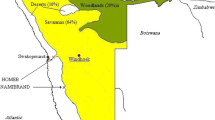Abstract
Subtropical evergreen and deciduous broadleaved mixed forests occur on shallow soils or even barren areas with carbonate bedrock in karst areas of southern China. The nature of seasonal water sources is poorly understood in the complex environment of these deeply rooted forests; these forests grow well despite frequent seasonal droughts and limited water availability. The authors hypothesized that trees here mainly adsorb water from deep root systems that also recharge the surface soil at least during the dry season. To test this hypothesis, seasonal isotopic hydrogen and oxygen compositions (δ18O and δD) of surface, different subsurface, well and xylem water available to Cyclobalanopsis glauca were compared in a subtropical mixed forest near Guilin, Guangxi, China. Levels of δ18O and δD in soil water decreased with depth in the 0–30 cm soil horizon and increased below 30 cm depth in March, July and October. However, in January the soil water δ18O and δD values decreased generally with soil depth. Deep root systems of trees were suspected to redistribute groundwater to shallow surface soils providing the main stable water source for adult C. glauca during the growing season (March–October). However, IsoSource outputs indicated that C. glauca extracts water mainly from shallow soil throughout the sampling year. In the cold and dry season (January), winter rains recharging soil water may provide most of the water available for transpiration. The two-tier water structure in this karst environment connected by deep roots appears to help form a closed water circulation of groundwater–soil–plant–atmosphere.





Similar content being viewed by others
References
Asbjornsen H, Mora G, Helmers MJ (2007) Variation in water uptake dynamics among contra sting agricultural and native plant communities in the Midwestern US. Agric Ecosyst Environ 121:343–356
Bleby TM, Mcelrone AJ, Jackson RB (2010) Water uptake and hydraulic redistribution across large woody root systems to 20 m depth. Plant Cell Environ 33:2132–2148
Brooks JR, Barnard HR, Coulombe R, McDonnell JJ (2009) Ecohydrologic separation of water between trees and streams in a Mediterranean climate. Nat Geosci 3:100–104
Brunel JP, Walker GR, Kennett-Smith AK (1995) Field validation of isotopic procedures for determining sources of water used by plants in a semi-arid environment. J Hydrol 167:351–368
Caldwell MM, Richards JH (1989) Hydraulic lift: water efflux from upper roots improves effectiveness of water uptake by deep roots. Oecologia 79:1–5
Chandler DG (2006) Reversibility of forest conversion impacts on water budgets in tropical karst terrain. For Ecol Manag 224:95–103
Clark ID, Fritz P (1997) Environmental isotopes in hydrogeology. Lewis, New York
Dansgaard W (1964) Stable isotopes in precipitation. Tellus 4:436–468
Dawsan TE, Pate JS (1996) Seasonal water uptake and movement in root systems of Australian phraeatophytic plants of dimorphic root morphology: a stable isotope investigation. Oecologia 107:13–20
Ehleringer JR, Dawson TE (1992) Water uptake by plants: perspectives from stable isotope composition. Plant Cell Environ 15:1073–1082
Hasselquist NJ, Allen MF, Santiago LS (2010) Water relations of evergreen and drought-deciduous trees along a seasonally dry tropical forest chronosequence. Oecologia 164:881–890
He SY, Ran JC, Yuan DX, Xie YQ (2001) A comparative study on hydrological and ecological effects in different karst ecosystems. Acta Geoscientica Sinica 22:265–270 (in Chinese)
Héctor EM, Louis SS, Robert CG, Michael FA, Juan JJO (2013) Source water, phenology and growth of two tropical dry forest tree species growing on shallow karst soils. Trees 27(5):1297–1307
Huang YQ, Zhao P, Zhang ZF, Li XK, He CX, Zhang RQ (2009) Transpiration of Cyclobalanopsis glauca (syn. Quercus glauca) stand measured by sap-flow method in a karst rocky terrain during dry season. Ecol Res 24:791–801
Huang YQ, Li XK, Zhang ZF, He CX, Zhao P, You YM, Mo L (2011) Seasonal changes in Cyclobalanopsis glauca transpiration and canopy stomatal conductance and their dependence on subterranean water and climatic factors in rocky karst terrain. J Hydrol 402:135–143
Li YB, Shao JG, Wang SJ, Wei CF (2006) A Conceptual Analysis of Karst Ecosystem Fragility. Prog Geogr 25:1–9
McCole AA, Stern LA (2007) Seasonal water use patterns of Juniperus ashei on the Edwards Plateau, Texas, based on stable isotopes in water. J Hydrol 342:238–248
Nie YP, Chen HS, Wang KL, Yang J (2011) Water source utilization by woody plants growing on dolomite outcrops and nearby soils during dry seasons in karst region of Southwest China. J Hydrol 420–421:264–274
Oliveira RS, Dawson TE, Burgess SSO, Nepstad DC (2005) Hydraulic redistribution in three Amazonian trees. Oecologia 145:354–363
Philips DL, Gregg JW (2003) Source partitioning using stable isotopes: coping with too many sources. Oecologia 136:261–269
Querejeta JL, Medina HE, Allen MF, Osornio JJJ (2007) Water source partitioning among trees growing on shallow karst soils in a seasonally dry tropical climate. Oecologia 152:26–36
Rose K, Graham R, Parker D (2003) Water source utilization by Pinus jeffreyi and Arctostaphylos patula on thin soils over bedrock. Oecologia 134:46–54
Schwinning S (2008) The water relations of two evergreen tree species in a Karst savanna. Oecologia 158:373–383
Williams PW (2008) The role of the epikarst in karst and cave hydrogeology: a review. Int J Speleol 37:1–10
Xu Q, Harbin L, Chen JQ, Cheng XL, Liu SR, An SQ (2011) Water use patterns of three species in subalpine forest, Southwest China: the deuterium isotope approach. Ecohydrology 4:236–244
You YM (2010) Study on Cyclobalanopsis glauca root vertical growth and its physioecology under simulated karst environment. Guangxi Normal University, Guilin (in Chinese)
Yuan DX (2001) World correlation of karst ecosystem: objectives and implementation plan. Adv Earth Sci 16:461–466 (in Chinese)
Acknowledgments
The National Natural Science Foundation of China (grant # 41172313 and 40872198), National Science and Technology Support Program (grant # 2011BAC09B02 and 2012BAC16B01) and Provincial Nature Science Foundation of Guangxi (grant # 2014GXNSFBA118110) supported this research.
Conflict of interest
The authors have no conflicts of interest to declare.
Author information
Authors and Affiliations
Corresponding author
Rights and permissions
About this article
Cite this article
Gu, D., Zhang, Z., Mallik, A. et al. Seasonal water use strategy of Cyclobalanopsis glauca in a karst area of southern China. Environ Earth Sci 74, 1007–1014 (2015). https://doi.org/10.1007/s12665-014-3817-1
Received:
Accepted:
Published:
Issue Date:
DOI: https://doi.org/10.1007/s12665-014-3817-1




